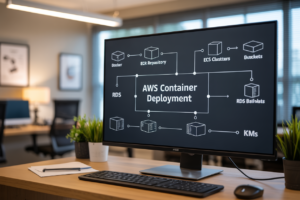Imagine a world where AI doesn’t just answer questions, but actively collaborates with you, understanding and leveraging the tools at its disposal. 🤖💡 This isn’t science fiction—it’s the reality being shaped by MCP, the Multi-Agent Collaboration Protocol.
Ever wondered how ChatGPT seamlessly integrates with various plugins, or how Claude effortlessly navigates complex tasks? The secret lies in MCP, the behind-the-scenes powerhouse that’s revolutionizing AI capabilities. But MCP isn’t just for tech giants; it’s a game-changer for developers and businesses looking to create truly tool-aware AI.
In this post, we’ll dive deep into the world of MCP, exploring its role in powering cutting-edge AI tools, and how you can harness its potential to build smarter, more capable AI systems. From understanding the basics to envisioning the future, we’ll cover everything you need to know about this transformative protocol. Let’s embark on this journey to unlock the full potential of AI with MCP!
Understanding MCP: The Protocol Powering AI Tools
Defining MCP and its significance
MCP, or Multi-modal Conversational Protocol, is a groundbreaking framework that enables seamless communication between AI models and external tools. Its significance lies in its ability to bridge the gap between language models and practical applications, allowing AI to interact with and utilize various tools effectively.
How MCP enables AI-tool interaction
MCP facilitates AI-tool interaction through a structured communication process:
- Tool registration
- Function calling
- Data exchange
- Result interpretation
This protocol allows AI models to understand tool capabilities, make appropriate calls, and process the returned information, creating a more versatile and capable AI system.
| MCP Component | Purpose |
|---|---|
| Tool Registry | Catalogs available tools and their functions |
| Function Caller | Enables AI to invoke specific tool actions |
| Data Formatter | Standardizes data exchange between AI and tools |
| Result Parser | Interprets tool outputs for AI comprehension |
Key features of MCP
- Flexibility: Supports various tool types and functionalities
- Scalability: Easily integrates new tools without modifying the AI model
- Standardization: Provides a uniform interface for diverse tools
- Error Handling: Manages exceptions and unexpected outputs gracefully
- Multi-modal Support: Handles text, images, and other data types
MCP’s key features make it an essential protocol for developing tool-aware AI, paving the way for more capable and versatile AI assistants like ChatGPT and Claude. As we explore the role of MCP in these advanced AI models, we’ll see how it enhances their functionality and user experience.
The Role of MCP in ChatGPT and Claude
Enhancing conversational abilities
MCP plays a crucial role in elevating the conversational capabilities of AI models like ChatGPT and Claude. By leveraging this protocol, these AI assistants can engage in more natural, context-aware dialogues with users. MCP enables:
- Improved turn-taking in conversations
- Better understanding of user intent
- More coherent and contextually appropriate responses
| Feature | Without MCP | With MCP |
|---|---|---|
| Context retention | Limited | Extended |
| Response relevance | Variable | Highly relevant |
| Conversation flow | Rigid | Natural and fluid |
Improving context understanding
The Multi-modal Conversational Protocol significantly enhances the context understanding abilities of AI models. This improvement allows ChatGPT and Claude to:
- Maintain coherence across multiple turns of conversation
- Recognize and adapt to changes in topic or user intent
- Incorporate information from previous exchanges into current responses
Enabling seamless tool integration
One of the most powerful aspects of MCP is its ability to facilitate seamless integration of external tools and APIs. This capability allows AI models to:
- Access real-time data and information
- Perform complex calculations or data processing tasks
- Interact with external systems and databases
Boosting response accuracy
By leveraging MCP, ChatGPT and Claude can dramatically improve the accuracy of their responses. This is achieved through:
- Access to up-to-date information
- Ability to cross-reference multiple sources
- Utilization of specialized tools for specific tasks
These improvements result in more reliable and trustworthy AI assistants, capable of handling a wider range of user queries and tasks with greater precision. As we explore the benefits of MCP-powered AI tools, we’ll see how these enhancements translate into tangible advantages for users and developers alike.
Building Tool-Aware AI with MCP
Fundamentals of tool-aware AI
Tool-aware AI represents a significant leap in artificial intelligence capabilities. These systems can understand, utilize, and interact with various tools and APIs to enhance their problem-solving abilities. The core principle lies in the AI’s ability to recognize when to use specific tools and how to interpret their outputs.
Key components of tool-aware AI include:
- Tool recognition
- Context understanding
- Output interpretation
- Decision-making
| Component | Description |
|---|---|
| Tool recognition | Ability to identify relevant tools for a given task |
| Context understanding | Comprehending the current situation and user needs |
| Output interpretation | Analyzing and utilizing tool outputs effectively |
| Decision-making | Choosing the best course of action based on tool results |
Implementing MCP in AI development
The Multi-modal Conversational Protocol (MCP) plays a crucial role in developing tool-aware AI. It provides a standardized framework for AI systems to communicate with various tools and APIs seamlessly. Implementing MCP involves:
- Defining tool interfaces
- Establishing communication protocols
- Creating response handlers
- Integrating with the AI’s decision-making process
Overcoming challenges in tool integration
Integrating tools with AI systems can present several challenges:
- Compatibility issues
- Data format inconsistencies
- Security concerns
- Performance bottlenecks
To address these challenges, developers must focus on creating robust APIs, implementing strong security measures, and optimizing data processing pipelines.
Best practices for MCP utilization
To maximize the benefits of MCP in tool-aware AI:
- Design modular tool interfaces
- Implement comprehensive error handling
- Regularly update tool libraries
- Prioritize user privacy and data security
- Continuously monitor and optimize performance
By following these best practices, developers can create powerful, flexible, and efficient tool-aware AI systems that leverage the full potential of MCP. This approach not only enhances the AI’s capabilities but also improves user experience and expands the range of tasks the AI can accomplish.
Benefits of MCP-Powered AI Tools
Increased versatility and functionality
MCP-powered AI tools offer a significant leap in versatility and functionality. By integrating various tools and capabilities, these AI assistants can handle a wide range of tasks seamlessly. For example, an MCP-enabled AI can switch between language translation, data analysis, and image generation without requiring separate applications.
| Functionality | Traditional AI | MCP-Powered AI |
|---|---|---|
| Task Switching | Limited | Seamless |
| Tool Integration | Minimal | Extensive |
| Adaptability | Low | High |
Enhanced user experience
The implementation of MCP in AI tools greatly improves the user experience by providing:
- Intuitive interactions
- Contextual understanding
- Personalized responses
Users can engage with these AI assistants more naturally, as the MCP allows for a more human-like conversation flow while leveraging multiple tools and capabilities.
Improved problem-solving capabilities
MCP-powered AI tools excel in problem-solving due to their ability to:
- Access and combine information from various sources
- Utilize different tools and methodologies
- Adapt to complex, multi-step problems
This enhanced problem-solving ability makes MCP-powered AI invaluable in fields such as research, engineering, and creative industries.
Potential for cross-platform compatibility
The standardization offered by MCP opens up exciting possibilities for cross-platform compatibility. AI tools using this protocol can potentially:
- Integrate with various operating systems and devices
- Share functionalities across different AI platforms
- Enable seamless collaboration between different AI assistants
This compatibility ensures that users can enjoy consistent experiences across multiple devices and platforms, further enhancing the utility of AI tools in both personal and professional settings.
The Future of AI with MCP
Emerging trends in MCP implementation
As the Multi-modal Conversational Protocol (MCP) continues to evolve, we’re seeing exciting trends in its implementation:
- Enhanced multi-modal capabilities
- Improved context understanding
- Seamless tool integration
- Real-time adaptation
These trends are paving the way for more versatile and powerful AI assistants. For instance, the enhanced multi-modal capabilities allow AI to process and generate various types of data, including text, images, and audio, creating a more immersive user experience.
| Trend | Description | Impact |
|---|---|---|
| Multi-modal capabilities | Process diverse data types | More immersive AI interactions |
| Context understanding | Better grasp of user intent | More accurate and relevant responses |
| Tool integration | Seamless access to external tools | Expanded AI capabilities |
| Real-time adaptation | Dynamic adjustments to user needs | Personalized AI experiences |
Potential applications beyond ChatGPT and Claude
The versatility of MCP opens up a world of possibilities beyond current AI assistants:
- Advanced medical diagnosis systems
- Intelligent tutoring platforms
- Complex scientific research assistants
- Creative content generation tools
These applications leverage MCP’s ability to integrate multiple tools and understand complex contexts. For example, a medical diagnosis system could combine natural language processing with access to medical databases and imaging analysis tools, providing more comprehensive and accurate diagnoses.
Impact on AI industry and innovation
MCP is set to revolutionize the AI industry by:
- Standardizing AI-tool interactions
- Accelerating development of new AI applications
- Fostering collaboration between AI systems
This standardization will likely lead to a more interconnected AI ecosystem, where different AI models can seamlessly work together, sharing capabilities and knowledge. As a result, we can expect to see a surge in innovative AI solutions across various sectors, from healthcare to education to creative industries.
MCP stands at the forefront of AI innovation, revolutionizing how AI tools interact with external resources and perform complex tasks. By enabling seamless communication between AI models and various tools, MCP empowers chatbots like ChatGPT and Claude to access real-time information, execute code, and provide more accurate and contextually relevant responses. This protocol not only enhances the capabilities of existing AI tools but also paves the way for more advanced, tool-aware AI systems in the future.
As we look ahead, the potential applications of MCP-powered AI are vast and exciting. From improving customer service to aiding in scientific research and decision-making processes, tool-aware AI has the power to transform industries and improve our daily lives. By embracing MCP and continuing to develop AI systems that can effectively leverage external tools, we can unlock new possibilities and push the boundaries of what artificial intelligence can achieve.




















